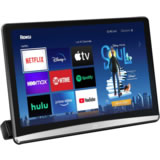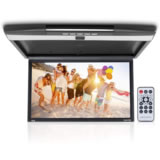California Vehicle TV Laws
Use of TVs or other screens and monitors in vehicles is governed by California Vehicle Code, Division 12: Equipment of Vehicles, Chapter 5: Other Equipment, Article 5: Fenders, Ornaments, and Television, Section 27612.
TV Monitors in California – Legal or not?
In state of California using TV screens in cars while driving is allowed as long as the screen is not visible to the driver. Laws regulate that TV monitors must be installed at any point behind the driver, or installed in such as way that drivers aren’t able to view it.
The laws make exceptions for GPS navigation devices, parking camera screens, or a vehicle information display. If the screen is capable of displaying television or receive other signals, it is unlawful to use it while driving.
Full section of California Vehicle Code regulating the use of TV monitors in cars is below. Make sure to read it through to fully understand whether your intended use is legal or illegal.
California VC, Section 27602:
(a) A person shall not drive a motor vehicle if a television receiver, a video monitor, or a television or video screen, or any other similar means of visually displaying a television broadcast or video signal that produces entertainment or business applications, is operating and is located in the motor vehicle at a point forward of the back of the driver’s seat, or is operating and the monitor, screen, or display is visible to the driver while driving the motor vehicle.
(b) Subdivision (a) does not apply to the following equipment when installed in a vehicle:
(1) A vehicle information display.
(2) A global positioning display.
(3) A mapping display.
(4) A visual display used to enhance or supplement the driver’s view forward, behind, or to the sides of a motor vehicle for the purpose of maneuvering the vehicle.
(5) A television receiver, video monitor, television or video screen, or any other similar means of visually displaying a television broadcast or video signal, if that equipment satisfies one of the following requirements:
(A) The equipment has an interlock device that, when the motor vehicle is driven, disables the equipment for all uses except as a visual display as described in paragraphs (1) to (4), inclusive.
(B) The equipment is designed, operated, and configured in a manner that prevents the driver of the motor vehicle from viewing the television broadcast or video signal while operating the vehicle in a safe and reasonable manner.
(6) A mobile digital terminal that is fitted with an opaque covering that does not allow the driver to view any part of the display while driving, even though the terminal may be operating, installed in a vehicle that is owned or operated by any of the following:
(A) An electrical corporation, as defined in Section 218 of the Public Utilities Code.
(B) A gas corporation, as defined in Section 222 of the Public Utilities Code.
(C) A sewer system corporation, as defined in Section 230.6 of the Public Utilities Code.
(D) A telephone corporation, as defined in Section 234 of the Public Utilities Code.
(E) A water corporation, as defined in Section 241 of the Public Utilities Code.
(F) A local publicly owned electric utility, as defined in Section 224.3 of the Public Utilities Code.
(G) A city, joint powers agency, or special district, if that local entity uses the vehicle solely in the provision of sewer service, gas service, water service, or wastewater service.
(c) Subdivision (a) does not apply to a mobile digital terminal installed in an authorized emergency vehicle or to a motor vehicle providing emergency road service or roadside assistance.
(d) Subdivision (a) does not apply to a mobile digital terminal installed in a vehicle when the vehicle is deployed in an emergency to respond to an interruption or impending interruption of electrical, natural gas, telephone, sewer, water, or wastewater service, and the vehicle is owned or operated by any of the following:
(1) An electrical corporation, as defined in Section 218 of the Public Utilities Code.
(2) A gas corporation, as defined in Section 222 of the Public Utilities Code.
(3) A sewer system corporation, as defined in Section 230.6 of the Public Utilities Code.
(4) A telephone corporation, as defined in Section 234 of the Public Utilities Code.
(5) A water corporation, as defined in Section 241 of the Public Utilities Code.
(6) A local publicly owned electric utility, as defined in Section 224.3 of the Public Utilities Code.
(7) A city, joint powers agency, or special district, if that local entity uses the vehicle solely in the provision of sewer service, gas service, water service, or wastewater service.
California law also permits monitors in utility company vehicles and other emergency vehicles. Using monitors while operating private cars is not legal if the driver can see it, so ensure they are turned off while driving. This includes tablets, laptops, or any other similar devices.
Violating vehicle equipment laws and using monitors to display prohibited content is punishable by law. You can get a traffic citation for distracted driving, and/or other penalties.




